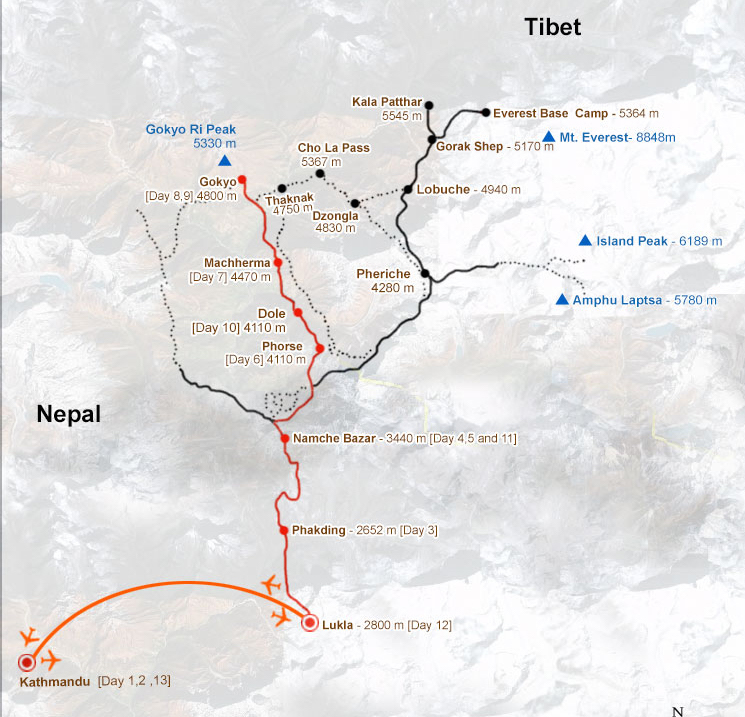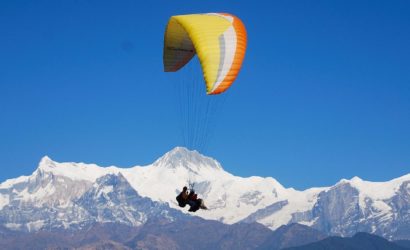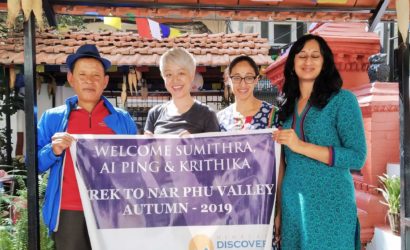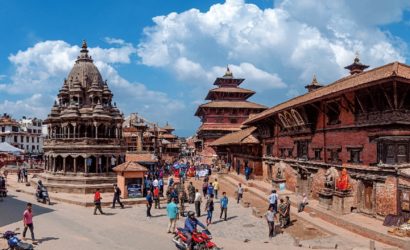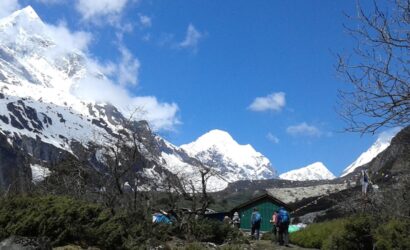Everest Gokyo Ri Trek is considered a traditional trek that offers magnificent views of the mountain peaks and the Ngozumpa Glacier- the largest in Nepal’s Himalayas. The image of this region is associated with the soaring views of the most popular mountains in Nepal, at an altitude of 8000m such as Cho Oyu, Everest, Lhotse and Makalu which are clearly visible from Gokyo Ri above Gokyo Lake.
One of the most remarkable features is the views of the tremendous ice ridge between Cho Oyu and Gyachung (2922m) located in Khumbu region. After a thirty-five minutes flight from Kathmandu / Manthali landing at Lukla’s tiny airstrip, the adventure of Everest Gokyo Ri trek begins.
We spend the next few days trekking and interacting among the mountain people also known as Sherpa’s, staying in local lodges and walking into their villages ‘ heartland. In conjunction with the local Sherpa guides, everything is organized.
We’re going to pass many Buddhist monasteries along the trek, with the views of Everest and other snowy mountains getting closer by the day. We will have days of rest in Namche bazaar villages that will enable us to discover and acclimatize the region, which is very important.
We return to Namche and Lukla for our flight back to Kathmandu after trekking to Gokyo Ri (5483 meters). If your time permits, you can start this trek from Jiri as well, but you will need to add 5/6 days extra in the itinerary.
Everest Gokyo Ri Trek Difficulty
Everest Gokyo Ri Trek is a moderate trekking grade. Although the trek does not require any technical climbing, it is because of the day-long treks that the Everest Gokyo Ri trek difficulty.
You will need to walk on a daily basis for at least 5 hours excluding the days of acclimatization. So, yes the trek is challenging for beginner trekkers in particular.
When summarized, this trek is an amazing and achievable experience. Even for first-time trekkers. But you may not be sure about the trek’s difficulty yet.
However, if you want to walk in the Everest region without the physical stress of reaching the Everest Base Camp, the Everest Gokyo Ri Trek is perfect. It’s less difficult to trek.
It is an alternative to the classic Everest Base Camp Trek.
This trek will take you through the Everest Region and the Gokyo Ri, the world’s highest mountain.
The Gokyo Valley is renowned for the “Gokyo Lakes,” a combination of large and enchanting glacial lakes. It’s another fascinating stop on the Gokyo Valley trek as well.
Upon your arrival in the Kathmandu airport after completing your custom formalities Visa, etc. pick up your luggage and look for our airport representative from Himalaya Discovery Adventures, who will display your name on the board at the arrival gate. You will be greeted by our representative and transferred to the hotel by private tourist vehicle. Overnight at hotel in Kathmandu.
Today is free for sightseeing in Kathmandu. You may wish to visit Durbar Square in the heart of the old city where the old Royal Palace, with its intricate woodcarving is located. The whole area is a maze of temples and images. Leading away from the square in all directions are narrow alleys, full of the most amazing variety of shops and stalls.
Some of these landmarks are considered World Heritage Sites including the historic Bhaktapur Durbar Square, the famous ‘Monkey Temple’ Swayambhunath and Buddhists shrine Buddhanath which is one of the largest Stupas in the world.
There will also be a full trip briefing today with gear check. In case you need to hire or buy equipment locally there will be time to do this today. Overnight in Kathmandu.
Everest Base Camp trek begins on the second day with a scenic flight from Manthali airport to Lukla Tenzing Hillary airport (2,804 m).
Upon arrival at Lukla, you will meet our porters who will be carrying your bags. The Everest Base Camp hike starts after a short glimpse of the village of Lukla, where you will pass the village of Chaurikharka and then descend towards Dudh Koshi and Ghat.
From there, you follow the trails to Phakding via the bank of the Dudh Koshi river and stay overnight at Phakding.
Please note: Kathmandu to Lukla flight has been moved to Manthali airport, Ramechhap in peak trekking season Spring (March, April, May) and Autumn (September, October, November) due to increased traffic and since March 2019 renovations at Kathmandu airport.
Manthali airport can be reached by road from Kathmandu within 4 to 6 hours drive. This means you need to wake up early in the morning around 2:30 am to take a drive and catch your Lukla flight from Manthali early in the morning. Overnight at guesthouse.
We continue trekking along the banks of the Dudhkosi, crossing this majestic river many times on exciting suspension bridges laden with prayer flags. After entering Everest National Park, the trail climbs steeply with breathtaking views.
Namche Bazaar known as the Gateway to Everest which is home to many quality restaurants, hotels, lodges, shops, Money exchange, internet cafe and a bakery. Namche is one of the biggest villages along the whole Everest trail. Overnight at guesthouse.
We will spend a day here in order to acclimatize and adjust to the thinning of the air. A short trek to a museum celebrating the traditional customs of the Sherpa people.
Today, we hike up the Syangboche Airport, and around Everest View Hotel. From this point, we have rewarding views of the Himalayas with a stunning sunrise or sunset over the panorama of the Khumbu peaks. Overnight at guesthouse.
Today, the trail climbs steeply out of valley through rhododendron forest, juniper and large conifers start to appear as the elevation increases making trekking beautiful in spring.
The trail passes through Yak Kharkas and summer settlements. The views of Ama Dablam, Khumbi La and Tawache are magnificent throughout the day. Overnight at guesthouse.
The trail climbs a ridge for an excellent view both down the valley to Kengtega and up towards Cho Oyu and descend to a river and again climbs steep to the terminal moraine of the Ngozumpz glacier. We will reach at Machherma by early noon. Overnight at guesthouse.
Today the trek takes us at one of our final destination, Gokyo (4790m). We will make this camp our base for 2 nights as we will have couple of hiking and sightseeing trips around Gokyo. Overnight at guesthouse.
Today, early in the morning we have steep climb up to the top of Gokyo Ri at elevation of 5483 meters, ample rewards to anyone that attempts this trip.
There are stunning views of the supper Gokyo Valley, the massive Ngozumpa Glacier and an incredible panoramic view of the whole Khumbu Himalayas, such as giants as Everest, Lhotse, Nuptse, Makalu, Cho-Oyu and Gychung Kang can be seen.
Those who discover the glacier and Gokyo peak are rewarded. This day we have for acclimatization and after noon back to the camp. Overnight at guesthouse.
Following same trail down, we will make our descent to Dole. Overnight at guesthouse.
Descend to Namche Bazaar via typical Sherpa village of Khumjung. Leaving the mountains behind us our descent continues back to the town of Namche Bazaar at elevation of (3440 meters). Overnight at guesthouse.
Finally, we return to Lukla where the trek started, which will seem like a lifetime ago. Enjoying time to reflect on the trek as a group and the personal achievement of all those who took part. Also giving you time to discover the town. Overnight at guesthouse.
Enjoying your last glimpse of the mountains you have recently visited for one last time on the 35 minute Scenic flight back to Kathmandu. You can rest and relax throughout the day.
In the evening we will have a farewell dinner in a traditional Nepalese restaurant with cultural performances. Overnight in Kathmandu.
It’s also spare day in case of bad weather in Lukla. If you get interested to take some gifts from Nepal for friends and relatives, visit to some nearby shops or go out in Thamel for typical Nepalese goods.
In the evening we will have a farewell dinner in a traditional Nepalese restaurant with cultural performances. Overnight in Kathmandu.
The trip concludes! We will drop you to the airport according to your flight schedule.


